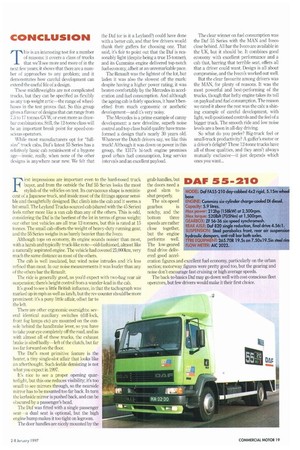F irst impressions are important even to the hard-nosed truck buyer,
Page 21

If you've noticed an error in this article please click here to report it so we can fix it.
and from the outside the Daf 55 Series looks the most stylish of the vehicles on test. Its curvaceous shape is reminiscent of a Japanese truck, and inside most of the fittings appear sensible and thoughtfully designed. But climb into the cab and it seems a bit small. The Leyland Trucks-sourced cab (shared with the 45 Series) feels rather more like a van cab than any of the others. This is odd, considering the Daf is the beefiest of the lot in terms of gross weight: our other test vehicles are all true I 2-tonners, but this is rated at 15 tonnes. The small cab offsets the weight of heavy-duty running gear, and the 55 Series weighs in as barely heavier than the Iveco.
Although tops on economy, its engine sounds noisier than most, with a harsh and typically truck-like note—old-fashioned, almost like a naturally aspirated engine. The vehicle had covered 21,000km, very much the same distance as most of the others.
The cab is well insulated, but wind noise intrudes and it's less refined than most. In our noise measurements it was louder than any of the others bar the Renault.
The ride is generally good, as you'd expect with two-bag rear air suspension; there's height control from a wander-lead in the cab.
It's good to see a little British influence, in that the tachograph was marked up in mph as well as kin/h, but the rev-counter should be more prominent: it's a puny little affair, offset far to the left.
There are other ergonomic oversights: several identical auxiliary switches (diff-lock, front fog lamps etc) are mounted on the console behind the handbrake lever, so you have to take your eye completely off the road, and as with almost all of these trucks, the exhaust brake is sited badly—left of the clutch, but far too far forward on the floor.
The Daf's most primitive feature is the heater, a tiny single-slot affair that looks like an afterthought. Such feeble demisting is not what you expect in 1997.
It's nice to see a proper opening guarterlight, but this one reduces visibility; it's too small to see mirrors through, so the nearside mirror has to be mounted too far back. In turn the kerbside mirror is pushed back, and can be obscured by a passenger's head.
The Daf was fitted with a single passenger seat—a dual seat is optional but the high engine hump makes it too tight on legroom.
The door handles are nicely mounted by the grab-handles, but the doors need a good slam to shut properly.
The six-speed
gearbox is notch); and the bottom three speeds are rather close together. but the engine performs well. The low-geared final drive delivered good acceleration figures and excellent fuel economy, particularly on the urban section; motorway figures were pretty good too, but the gearing and noise don't encourage fast cruising or high average speeds.
The back-to-basics Daf may go down well with cost-conscious fleet operators, but few drivers would make it their first choice.
Capacity. 5.9 litres.
Max pov, 212hp (158kW) at 2,500rpm.
Max tore 5201bit (705Nm) at 1,500rpm.
GEARBO ZF 56-36 six-speed synchromesh.
REAR AXi Daf 820 single reduction, final drive 4.56:1.
SIJSPEN5 Steel parabolics front, rear air suspension hydraulic dampers, anti-roll bar both axles. TYRE EQUIPMENI: 265.70R 19.5s on 7.50x19.5in steel rim FLOW METER: AIC 2022.
















































































